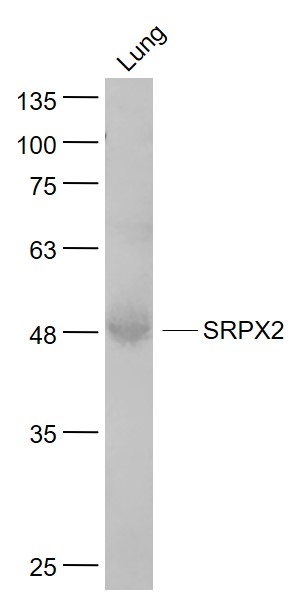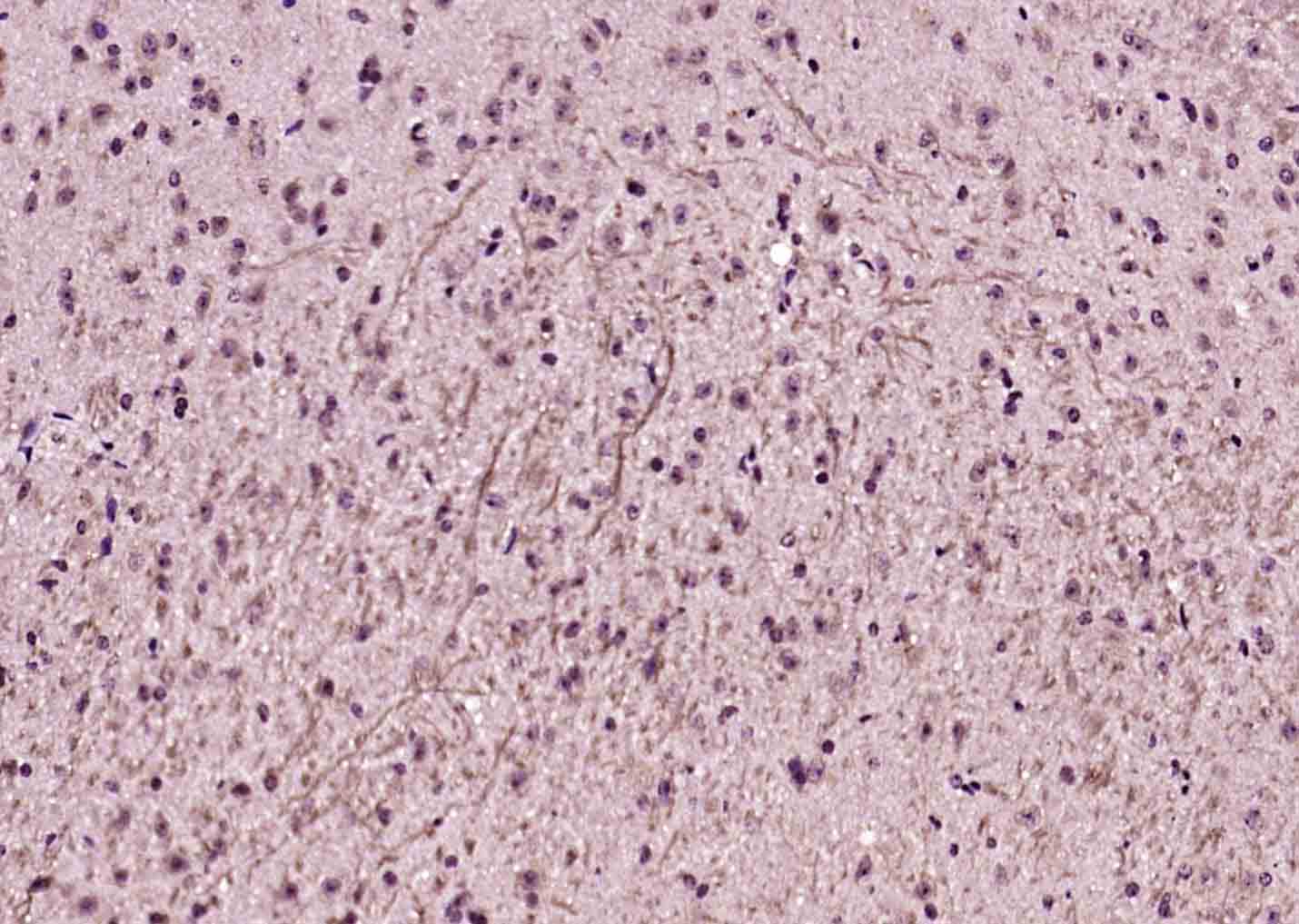
Rabbit Anti-SRPX2 antibody
SRPX2 is a 465 amino acid secreted protein expressed in neurons of the brain, including the rolandic area. It has been suggested that SRPX2 enhances cell motility, migration and adhesion through FAK signaling in gastric and other cancer cells. Localized t
View History [Clear]
Details
Product Name SRPX2 Chinese Name SRPX2蛋白抗体 Alias SRPX2 is a 465 amino acid secreted protein expressed in neurons of the brain, including the rolandic area. It has been suggested that SRPX2 enhances cell motility, migration and adhesion through FAK signaling in gastric and other cancer cells. Localized to the cytoplasm, SRPX2 is a ligand for uPAR (urokinase plasminogen activator), a receptor that is a crucial component of the extracellular plasminogen proteolysis system. SRPX2 may be responsible for rolandic seizures (RSs) associated with oral and speech dyspraxia and mental retardation (MR). The involvement of SRPX2 in these disorders suggests an important role for SRPX2 in the perisylvian region critical for language and cognitive development; SRPX2_HUMAN. Research Area Tumour Neurobiology Immunogen Species Rabbit Clonality Polyclonal React Species Mouse, (predicted: Human, Rat, ) Applications WB=1:500-2000 ELISA=1:5000-10000 IHC-P=1:100-500 IHC-F=1:100-500 ICC=1:100-500 IF=1:100-500 (Paraffin sections need antigen repair)
not yet tested in other applications.
optimal dilutions/concentrations should be determined by the end user.Theoretical molecular weight 50kDa Cellular localization cytoplasmic Secretory protein Form Liquid Concentration 1mg/ml immunogen KLH conjugated synthetic peptide derived from human SRPX2: 121-220/465 Lsotype IgG Purification affinity purified by Protein A Buffer Solution 0.01M TBS(pH7.4) with 1% BSA, 0.03% Proclin300 and 50% Glycerol. Storage Shipped at 4℃. Store at -20 °C for one year. Avoid repeated freeze/thaw cycles. Attention This product as supplied is intended for research use only, not for use in human, therapeutic or diagnostic applications. PubMed PubMed Product Detail SRPX2 is a 465 amino acid secreted protein expressed in neurons of the brain, including the rolandic area. It has been suggested that SRPX2 enhances cell motility, migration and adhesion through FAK signaling in gastric and other cancer cells. Localized to the cytoplasm, SRPX2 is a ligand for uPAR (urokinase plasminogen activator), a receptor that is a crucial component of the extracellular plasminogen proteolysis system. SRPX2 may be responsible for rolandic seizures (RSs) associated with oral and speech dyspraxia and mental retardation (MR). The involvement of SRPX2 in these disorders suggests an important role for SRPX2 in the perisylvian region critical for language and cognitive development.
Function:
Acts as a ligand for the urokinase plasminogen activator surface receptor. Plays a role in angiogenesis by inducing endothelial cell migration and the formation of vascular network (cords). Involved in cellular migration and adhesion in cancer cells. Increases the phosphorylation levels of FAK. May have a role in the perisylvian region, critical for language and cognitive development.
Subunit:
Interacts with ADAMTS4, CTSB and PLAUR. Interacts with PLAUR (via the UPAR/Ly6 domains).
Subcellular Location:
Cytoplasm. Secreted.
Tissue Specificity:
Expressed in neurons of the rolandic area of the brain (at protein level). Highly expressed in the brain, placenta, lung, trachea, uterus and adrenal gland. Weakly expressed in the peripheral blood, brain and bone marrow. Expressed in numerous cancer cell lines.
DISEASE:
Defects in SRPX2 are a cause of bilateral perisylvian polymicrogyria (BPP) [MIM:300388]. BPP is the most common form of polymicrogyria, a malformation of the cortex, in which the brain surface is irregular and the normal gyral pattern replaced by multiple small, partly fused, gyri separated by shallow sulci. BPP results in mild mental retardation, epilepsy and pseudobulbar palsy, causing difficulties with expressive speech and feeding.
Defects in SRPX2 are a cause of rolandic epilepsy with speech dyspraxia and mental retardation X-linked (RESDX) [MIM:300643]. A condition characterized by the association of rolandic seizures with oral and speech dyspraxia, and mental retardation. Rolandic occur during a period of significant brain maturation. During this time, dysfunction of neural network activities such as focal discharges may be associated with specific developmental disabilities resulting in specific cognitive impairments of language, visuo-spatial abilities or attention.
Similarity:
Contains 1 HYR domain.
Contains 3 Sushi (CCP/SCR) domains.
SWISS:
O60687
Gene ID:
27286
Database links:Entrez Gene: 27286 Human
Entrez Gene: 68792 Mouse
Omim: 300642 Human
SwissProt: O60687 Human
SwissProt: Q8R054 Mouse
Product Picture
Lung (Mouse) Lysate at 40 ug
Primary: Anti- SRPX2 (SL11967R) at 1/1000 dilution
Secondary: IRDye800CW Goat Anti-Rabbit IgG at 1/20000 dilution
Predicted band size: 50 kD
Observed band size: 48 kD
Paraformaldehyde-fixed, paraffin embedded (mouse brain); Antigen retrieval by boiling in sodium citrate buffer (pH6.0) for 15min; Block endogenous peroxidase by 3% hydrogen peroxide for 20 minutes; Blocking buffer (normal goat serum) at 37°C for 30min; Antibody incubation with (SRPX2) Polyclonal Antibody, Unconjugated (SL11967R) at 1:200 overnight at 4°C, followed by operating according to SP Kit(Rabbit) (sp-0023) instructionsand DAB staining.
Partial purchase records(bought amounts latest0)
No one bought this product
User Comment(Total0User Comment Num)
- No comment




 +86 571 56623320
+86 571 56623320




